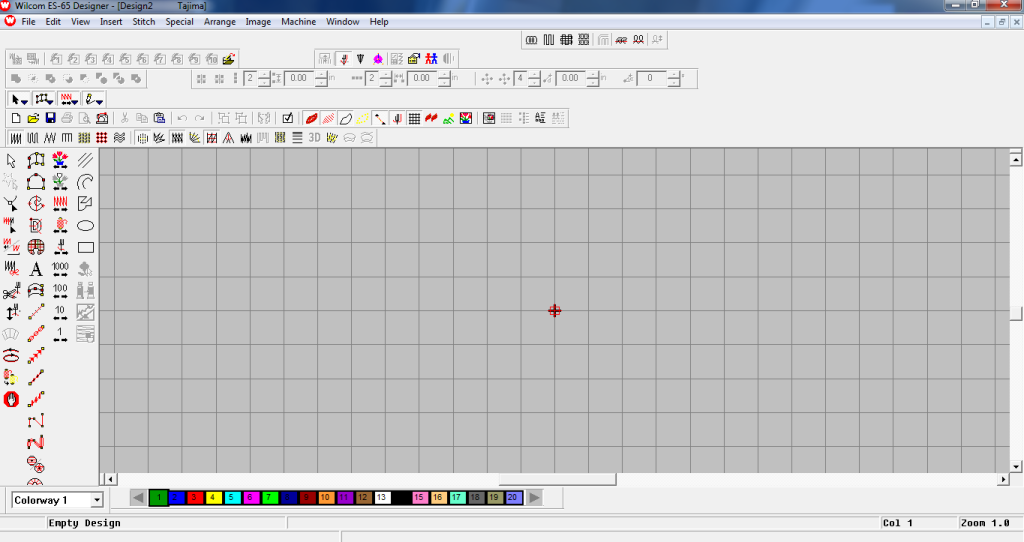Wilcom is a comprehensive tool for embroidery digitizing, offering both manual and automatic digitizing options. Its wide range of tools and features allows for detailed customization and optimization, ensuring high-quality embroidery results. Whether you are a beginner or an experienced digitizer, Wilcom provides the necessary tools to create intricate and professional embroidery designs.
Wilcom allows a certain process where artworks are converted into a desired file format according to embroidery machine requirements to read instructions and run accordingly. Here’s a comprehensive overview for how Wilcom works for embroidery digitizing:
Software Interface and Tools
User Interface: Wilcom software is designed to be user-friendly with toolbars, menus, and panels that provide easy access to various features to digitize a logo. It includes a workspace where users can view and use artwork as tracing.
Wilcom Design Tools:
Drawing Tools: Users can create shapes and lines using tools like the pen, pencil, and shape tools. All these tools are used to customize your artwork for embroidery digitizing.
Text Tools: Allows for the addition of text, with options to choose from a wide range of fonts specifically designed for embroidery. Wilcom has a variety of fonts which makes it easy to replace rather than digitizing manually. We have the option to install more fonts as per requirements.
Editing Tools: Wilcom is user friendly and has many tools for resizing, rotating, and skewing objects, along with options for color selection and pattern fills.

Importing and Creating Designs
Importing Artwork: Users can import artwork from various formats (such as JPG, PNG, BMP) into Wilcom. The software allows users to trace these images and convert them into embroidery file formats as per embroidery machine.
Creating from Scratch: As Wilcom is equipped with drawing tools so users can also create his own designs from scratch. Using these drawing tools; we can make multiple shapes, patches and borders.
Digitizing Process
Vector Conversion: Users can manually convert artwork into vector shapes that represent the stitch areas. With certain tools we can convert those shapes into embroidery stitches and can save these shapes in embroidery file formats.
Stitch Types: Wilcom allows choosing the type of stitch for different parts of the design (e.g., satin, fill, running stitches). Each stitch type has specific properties and uses as per machine properties. For example; sometime satin stitch is too wide for embroidery machine limits so Wilcom allows us to use fill stitch for those areas where machine limits end.
Color Change Options: Using Wilcom we can digitize multicolor logos. Color management tools allow us to minimize stitching time.
Automatic Conversion: Wilcom offers auto-digitizing features where the software automatically converts imported artwork into stitch files. Automation tools are limited and require editing according to fabric and machine properties.
Stitch Settings and Customization
Stitch Parameters:
Density: Wilcom allows digitizers to adjust stitching density according to fabric and machine. For example; if the fabric is too thick more will be stitching density, if fabric is thin like shirts less will be stitching density. Choosing the right density; we can save our embroidery cost and fabric damage.
Underlay: Wilcom allows adding underlay stitches to stabilize the fabric and provide a foundation for top stitches. Variety of underlay allows digitizer to choose right underlay for right fabric.
Compensation: Advanced feature in Wilcom allows adjusting for fabric pull by widening or narrowing the stitches. It will help digitizers to make borders without leaving space.
3D/Puff: Wilcom allows creating raised embroidery effects by adjusting stitch parameters. These effects are usually used for caps by placing foam under stitching. Using the right density; digitizer can make it look like 3D effects in stitching.
Appliqué: Where stitching areas are too large for using stitching; Wilcom can be used to design for appliqué, where pieces of fabric are sewn onto the base fabric instead of fill stitches. It saves embroider and thread cost and machine stitching time as well.
Output and Machine Compatibility
File Formats: Wilcom supports around 35 embroidery machine file formats e.g. *.DST, *.EXP, *.JEF, *.HUS and many more to ensure compatibility with different brands and models of embroidery machines. DST tagima is most popular these days and widely used all over the world for commercial use.
Machine Settings: Embroidery Digitizer can specify machine settings such as thread colors, hoop size, and machine type. This ensures that the design is optimized for the specific machine that will be used.
Updates
Updates: Wilcom software receives regular updates to improve functionality, add new features, and ensure compatibility with the latest embroidery machines.



